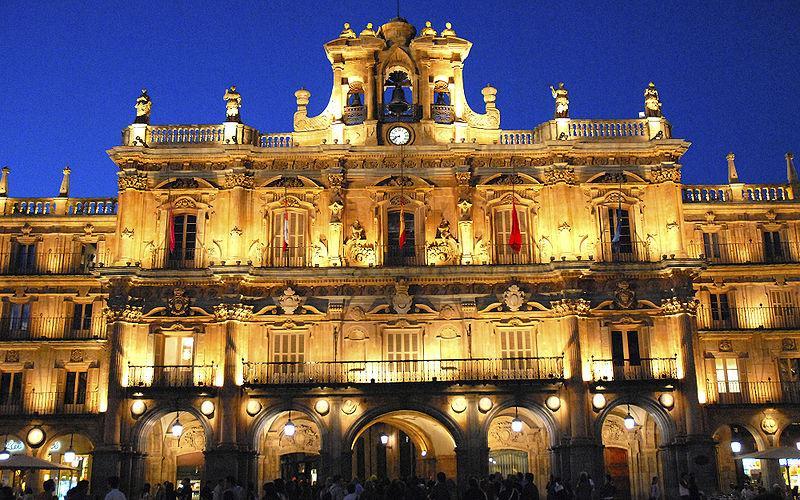Salamanca, Castela e Leão, Spain
Suggest Place to Visit
5049
Track to location with GPS |
 |
Old history
The vetones had more presence than the vaceos, which gave a strong personality in the area of the current provinces of Ávila, Toledo and Salamanca.
In the III century a. C., Aníbal, in his advance through Iberia, besieges and takes the ancient city of Helmantica (Salamanca). Legend has it that the Salamancans surrendered the square without offering resistance and left the city; but the women wore the men's weapons under their dresses, with which they later besieged the Carthaginians within the city.
With the fall of the Carthaginians to the Romans, the occupation was consolidated and the city began to acquire some importance. It soon became a basic commercial enclave due to its privileged location as a ford over the Tormes river, which in turn makes it a passage for one of the most important Roman roads in Hispania, the Vía de la Plata. The Roman bridge (1st century) was built for this road, of which the northern half still stands today (the other half had to be rebuilt in the 17th century after the Flood of San Policarpo).
Medieval history
With the end of the Roman Empire, the Alans settled in Lusitania and the city became part of this region. Later the Visigoths conquer the city and annex it to their territory. There is little data on the development of Salamanca in the Visigothic period, it is only known that in the 4th century the Roman wall was extended with towers on the same route, and that the factory of the previous fence was almost completely destroyed. It is known that in 589 the city was the episcopal seat as it is one of the cities that sent bishops to the councils of Toledo.
In 712, with the Muslim invasion of the peninsula, Musa ibn Nusair conquered the city. During the High Middle Ages, the area remained a no-man's-land and a large part of its population centers were frequently destroyed by the frequent incursions (riot) of the Arabs. Salamanca was reduced to a nucleus devoid of importance and practically depopulated. The successive attempts of the Christian kingdoms to stabilize this area caused many clashes with the Muslim expeditions to the north, which provoked various skirmishes and battles, such as that of Alfonso I in 754, which ended up devastating what remains of the urban area. The area remains practically uninhabited until after the important Christian victory, in the battle of Simancas in 939, a timid repopulation of the riverside area of the Tormes begins, which will not have any success against the still all-powerful Caliphate.
After the conquest of Toledo by Alfonso VI, in the year 1085, the definitive repopulation of the city took place. In 1102, Raimundo de Borgoña went to the city with a large group of settlers of various origins, by order of his father-in-law Alfonso VI. Each of these groups settled in a different area of the city. Franks, Serranos (from the Serranías de Urbión, La Demanda and Covaleda, between the current provinces of Burgos, Soria and La Rioja), Castilian, Portuguese, Mozarabic (Hispanic-Roman or Hispanic-Gothic populations who fled Muslim rule), Toreans, Jews and Galicians founded their respective Churches and parishes. His Diocese is restored (being the first bishop Jerónimo de Perigord) and the construction of the cathedral begins, at whose side some schools are born that will be the germ of the University.
In the year 1230, under the reign of Fernando III El Santo, the kingdoms of Castilla y León were definitively united.
In the 13th century, the monarch Alfonso IX of León granted the cathedral schools the rank of General Study which, in 1253, would become the University of Salamanca by royal decree of Alfonso X, later ratified by Pope Alexander IV (1255). The university would achieve great prestige over time.
On August 12, 1311, the only king of Castilla y León that has given the city, Alfonso XI el Justiciero, was born within its walls. He acceded to the throne when he was fourteen years old and conquered Gibraltar under the command of the Castilian-Leonese militias, in which the large presence of Salamanca contingents stood out.
During the 15th century, Salamanca was the scene of great rivalries between the noble families of the city, divided into two camps that divided the city: that of San Benito and that of Santo Tomé. With the rise of the Mesta, Salamanca became important as a center for cloth manufacturing and as an exporter of wool.
Modern history
Like the rest of the historical nuclei of the Crown that had representation in the Cortes, Salamanca joined the movement of the Communities of Castile (1520) against the new taxes demanded by Carlos I in the Cortes and in defense of its textile manufactures against the privileges of wool exporters. After the defeat of the Communards, King Carlos I had the towers of the palaces of the Salamancans who joined the revolt removed.
The 16th century was the time of greatest splendor of the city, both in demography and in university life, thanks to the prestige of its professors, with the so-called School of Salamanca (it is estimated that Salamanca had about 24,000 inhabitants and around 1580 they were enrolled 6,500 students every year). Later it joined the general decline of the cities of the Crown of Castile on the northern plateau (12,000 inhabitants in 1651).
In the eighteenth century it had an important economic and cultural renaissance, which led to the completion of the New Cathedral (whose works had been stopped for almost a century), the construction of its imposing Baroque main square in 1729 and allowed to rebuild many of the monumental buildings damaged by the Lisbon earthquake of 1755. In the cultural aspect, the influence of the Enlightenment of the Bourbons was also noted in the University in the last third of the century.
Contemporary history
During the War of Independence, Salamanca was occupied by the troops of Marshal Soult in 1809 and remained in French hands until the Battle of the Arapiles (1812), in which the allied armies under the command of Wellington won. During the occupation, the French built defenses and, to obtain materials, destroyed an important part of the Salamanca buildings, especially in the neighborhood called Caídos, where well-known university colleges were built, of which no trace remains. The worst moment came when Fernando VII closed the Spanish universities. As of the reopening, the one in Salamanca was reduced to a provincial university.
In 1873, after proclaiming the First Republic, Salamanca suffered a cantonal uprising that was put down.
During the rest of the 19th century, the city underwent a slight recovery as it was named provincial capital and the railway linking France with Portugal was built, passing through the Meseta (Medina del Campo and Salamanca, 1877).
Salamanca is a Spanish city, capital of the homonymous province, located in the autonomous community of Castilla y León. It has a population of 155,740 inhabitants, and its metropolitan area reaches 210,250 (2010 data), which makes it the second most populated area in Castilla y León after Valladolid. It is located in Campo Charro, next to the river Tormes.
Salamanca is home to the oldest university in Spain, the University of Salamanca, founded in 1218 by Alfonso IX of León, and the first in Europe to hold the title of University by the 1253 edict of Alfonso X of Castilla y León and the bull of Pope Alexander IV in 1255. During the time when it was one of the most prestigious universities in the West, the phrase became popular: Quod natura non dat, Salamantica non praestat, which means "What nature does not give, Salamanca does not provide" .
Salamanca is linked to Universal History by proper names such as: Antonio de Nebrija, Cristóbal Colón, Fernando de Rojas, Francisco de Vitoria and the School of Salamanca, Fray Luis de León, or Miguel de Unamuno. Even Miguel de Cervantes Saavedra states in his book El Licenciado Vidriera:
In Salamanca there are important research centers, such as the Cancer Research Center, the Institute of Neurosciences of Castilla y León (INCYL), the Center for Research and Technological Development of Water (CIDTA) and the Center for Ultra-short Ultra-Intense Pulsed Lasers ( CLPU). The city is the headquarters of financial entities such as Caja Duero.
After the war, the documents seized by the rebel army as they occupied the territory that had defended the Republic were concentrated in Salamanca, thus creating a large documentary archive on the Spanish civil war (General Archive of the Spanish Civil War ). The part of this archive belonging to Catalonia was transferred to Barcelona in the spring of 2006, after major disputes between the Salamanca city council and the Spanish government, and popular demonstrations. The Salamanca city council, chaired by Julián Lanzarote, changed the name of the street where the archive is located, from "Gibraltar" (a name that paid homage to the Salamanca militias who went with Alfonso XI to conquer Gibraltar) to " El Expolio ”, as a sign of protest after the transfer of the“ Salamanca papers ”to Catalonia.
In 1940, Pius XII founded the Pontifical University of Salamanca as a continuation of the old studies in theology.
In 1988 Salamanca was declared a World Heritage City by Unesco. In 1998, by agreement of the Ministers of Culture of the European Union, Salamanca is designated, together with Bruges, European Capital of Culture for 2002. The city also aspires to obtain the candidacy for the Salamanca Expo in the not very future far.
Currently the population of the capital of Salamanca, stagnant for about three decades, is around 160,000 inhabitants, although in 2006 it decreased by more than 11,000 people compared to 1994. This is mainly due to the transfer of part of its population to the metropolitan area, A phenomenon common to many other Spanish cities, although there is also a high rate of emigration to places like Madrid. It is significant to verify that the province of Salamanca has a high rate of aging population compared to national data.
For its part, the services sector (the buoyant cultural tourism and the University) is the main source of income for the city. Educational activity during the summer is especially relevant, since it has a large influx of students from many countries, most of whom come to learn Spanish and attend various summer courses.
The Salamanca capital hosted on October 14 and 15, 2005 the celebration of the XV Ibero-American Summit of Heads of State and Government.
Folklore and customs
The people of Salamanca are also known as charros and the surrounding countryside is called Campo Charro.
The bulls of the charro field are called salamanquinos and this term is considered an insult when used with a person.
A popular accessory for men's capes and charro dress is the charro button.
The celebration of Holy Week is very traditional, with more than 7 centuries of existence and notable and artistic processional steps by authors such as Luis Salvador Carmona, Alejandro Carnicero, Inocencio Soriano Montagut, Mariano Benlliure or Damián Villar.
On Monday of waters (Monday following Easter Monday) it is traditional to go out to the country to eat the hornazo. This tradition occurs throughout the province, although outside the capital the hornazo is eaten on Sunday or Easter Monday.
Anecdotal
The frog that appears on one of the skulls that decorate the façade of the original university building constitutes by itself one of the main tourist attractions of the city and also has its history. According to legend, the student who cannot see her fails the course. The reality is that, most likely, originally it symbolized lust (since in reality it is not a frog, but a toad, symbol of the female sex) that leads to death (the skull on which it is) and It was a reminder to the students (then entirely male) that they should focus their efforts on studying and not indulging in lust.
The Jewish quarter of Salamanca was located to the north, next to the wall (more or less the current avenue de Mirat). When, in 1492, they were expelled, the neighborhood was walled up and respected by the Salamancans, probably thinking of a possible return, and when it was left uninhabited it was filled with rabbits, which is why it has been known until recently as the Conejal neighborhood.
On the Carvajal slope is the Salamanca Cave, where according to tradition the Devil taught; Therefore, in a part of Spanish America, a Salamanca is a cave of witches.
A popular legend says that Tentenecio Street owes its name to the fact that once San Juan de Sahagún was walking along it, a huge bull that had escaped from the market and was running madly approached him. Sahagun yelled at him "Tente, fool!" and the bull, surprisingly, stood meekly. The street owes its name to this legend. Another street related to the saint is that of Pozo Amarillo, where he rescued a child who had fallen into the well causing the water level to rise. Today San Juan de Sahagún is the patron of the city.
For a long time, the university students were housed in colleges that were scattered throughout the old quarter. Each of them was distinguished from the others by their uniform, whose colors were reminiscent of certain birds. For this reason, in the city it was said that the schools were like nests that were sheltered in the crown of the university tree and swallows (Dominican schoolboys), pardales (Franciscans), storks (Mercedarians), cranes (bernardos) came to nest. thrushes (Jerónimos), pigeons (Mostenses), greenfinches (those of San Pelayo) ...
The House of Death is named after the skulls (in Salamanca skulls were called, deaths) that adorn its facade. On one occasion when the building was renovated, the skulls were rounded and turned into balls, but it remained such a gloomy name and this was reason enough for the popular imagination to invent a legend that ran for many years. According to her, the name came from the fact that a woman was found dead in the house without anyone explaining how the misfortune had occurred. The curse weighed on the house and everyone who lived in it would die. This resulted in it remaining empty for a long time and people passing by it mysteriously lowered their voices. Currently the spheres have been re-sculpted as skulls (much smaller than the originals).
In the book El Lazarillo de Tormes there is a scene that takes place in Salamanca. Next to the Roman bridge there is a stone sculpture representing a boar or a bull. Supposedly there the blind man said to Lazarillo: "Place your ear close to the bull and you will hear the water pass by," after which the blind man gave him a superb blow against the stony boar. According to this book, Lázaro de Tormes was born in the town of Tejares, which has been a Salamanca neighborhood since the 70s.
The Mariquelo is a typical character from Salamanca who every year on the eve of the feast of All Saints climbs the bell tower of the new cathedral to commemorate the fact that the Lisbon Earthquake of 1755 rang the bells, greatly affecting the structure of tower. Since then, a male from the Mariquelos family has followed the tradition until 1976, when this custom died. In 1985, Ángel Rufino de Haro decided to resume the tradition and every year, dressed in the typical charro costume, he climbs to the highest point of the cathedral tower to play a charrada with the tambourine and bagpipes.
Gibraltar and Setenil streets (today Patio Chico) are so called because the armies of the Castilian kings who conquered these cities from the Arabs in the 14th and 15th centuries were mainly made up of city council militias. Although Mayor Julián Lanzarote decided to change the name of Calle Gibraltar to Calle del Expolio on February 27, 2006, in full controversy over the "looting" of the Salamanca papers.
During the construction of the Clerecía, the Jesuits made the population believe that a treasure was hidden behind some of the shells that adorns the facade of the opposite building, the well-known Casa de las Conchas. In this way the people would tear down the building and thus they could expand the already gigantic and powerful group of the Clergy.
What is now called Cueva de Salamanca, is actually part of the sacristy of the now-defunct Church of San Cebrián. Here, according to legend, Satan disguised as a sacristan taught occult science classes to seven students for seven years, at the end of which one of them should remain at his service, the best known of them being the Marquis of Villena.
It is supposed to be one of the main accesses to the Salamanca subsoil.
Comments
We don´t have yet any comments about:
Salamanca
Salamanca
Be the first to leave a comment as it is very important to inform other people
Outros locais a visitar
Within a radius of 20 km from:Salamanca
Plaza Bürgermeister von Salamanca |
| 0,2 Km |
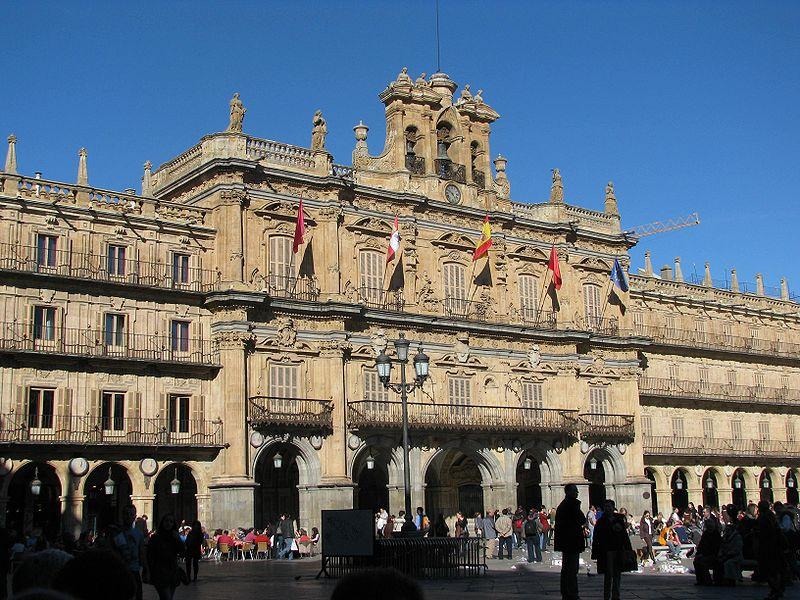 |
Monterrey Palace (Salamanca) |
| 0,4 Km |
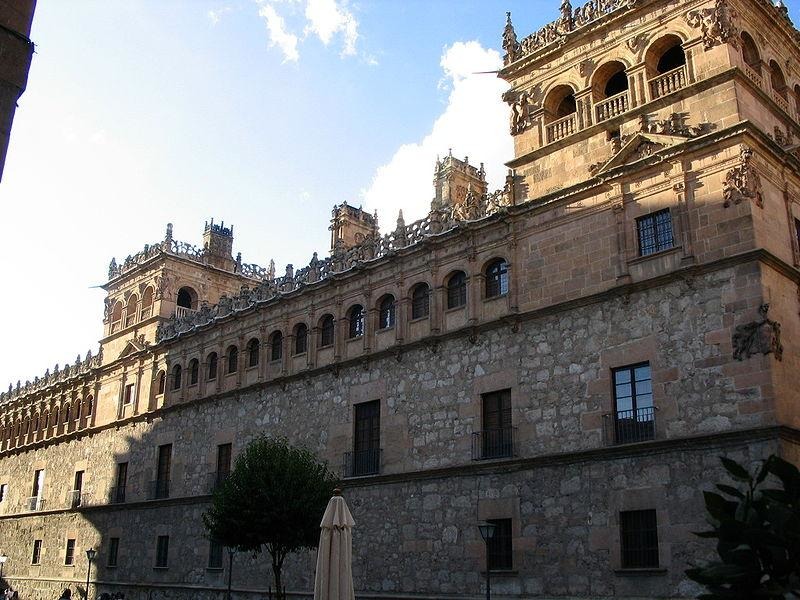 |
Universität von Salamanca |
| 0,6 Km |
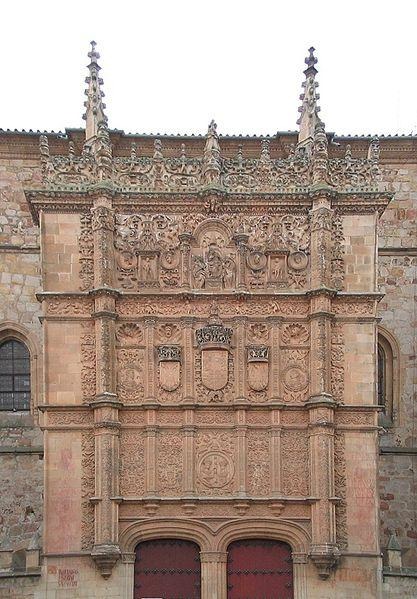 |
Casa Lis (Salamanca) |
| 0,8 Km |
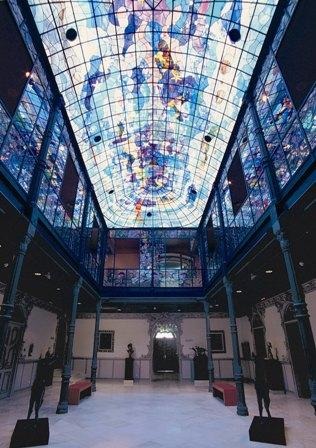 |
Hotel reservation near Salamanca within a radius of 20 km
Why to book with TOURISTISCHE ROUTEN
The best prices
Our partnerships with the world´s largest operators offer research on the best market prices.
More options
At Rotas Turisticos you can book the hotel, buy the air ticket, book the transfer from the airport to the hotel and vice versa, book the local excursions, rent the car, take travel insurance and consult the places to visit and where to go.
Holiday Tips & Destinations
Hundreds of holiday destinations with all the options that allow you to easily choose the destination that best suits your dream vacation.
TOURISTISCHE ROUTEN
Links


